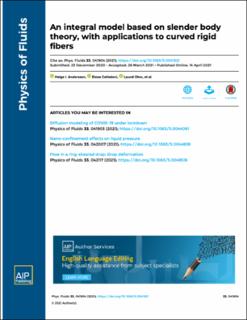| dc.contributor.author | Andersson, Helge Ingolf | |
| dc.contributor.author | Celledoni, Elena | |
| dc.contributor.author | Ohm, Laurel | |
| dc.contributor.author | Owren, Brynjulf | |
| dc.contributor.author | Tapley, Benjamin | |
| dc.date.accessioned | 2022-10-26T08:27:25Z | |
| dc.date.available | 2022-10-26T08:27:25Z | |
| dc.date.created | 2021-04-28T14:21:14Z | |
| dc.date.issued | 2021 | |
| dc.identifier.citation | Physics of Fluids. 2021, 33 (4), . | en_US |
| dc.identifier.issn | 1070-6631 | |
| dc.identifier.uri | https://hdl.handle.net/11250/3028340 | |
| dc.description.abstract | We propose a novel integral model describing the motion of both flexible and rigid slender fibers in viscous flow and develop a numerical method for simulating dynamics of curved rigid fibers. The model is derived from nonlocal slender body theory (SBT), which approximates flow near the fiber using singular solutions of the Stokes equations integrated along the fiber centerline. In contrast to other models based on (singular) SBT, our model yields a smooth integral kernel which incorporates the (possibly varying) fiber radius naturally. The integral operator is provably negative definite in a nonphysical idealized geometry, as expected from the partial differential equation theory. This is numerically verified in physically relevant geometries. We discuss the convergence and stability of a numerical method for solving the integral equation. The accuracy of the model and method is verified against known models for ellipsoids. Finally, we develop an algorithm for computing dynamics of rigid fibers with complex geometries in the case where the fiber density is much greater than that of the fluid, for example, in turbulent gas-fiber suspensions. | en_US |
| dc.language.iso | eng | en_US |
| dc.publisher | American Institute of Physics | en_US |
| dc.title | An integral model based on slender body theory, with applications to curved rigid fibers | en_US |
| dc.type | Peer reviewed | en_US |
| dc.type | Journal article | en_US |
| dc.description.version | publishedVersion | en_US |
| dc.rights.holder | © 2021 Author(s). Published under license by AIP Publishing. | en_US |
| dc.source.pagenumber | 24 | en_US |
| dc.source.volume | 33 | en_US |
| dc.source.journal | Physics of Fluids | en_US |
| dc.source.issue | 4 | en_US |
| dc.identifier.doi | 10.1063/5.0041521 | |
| dc.identifier.cristin | 1906996 | |
| cristin.ispublished | true | |
| cristin.fulltext | original | |
| cristin.qualitycode | 2 | |
